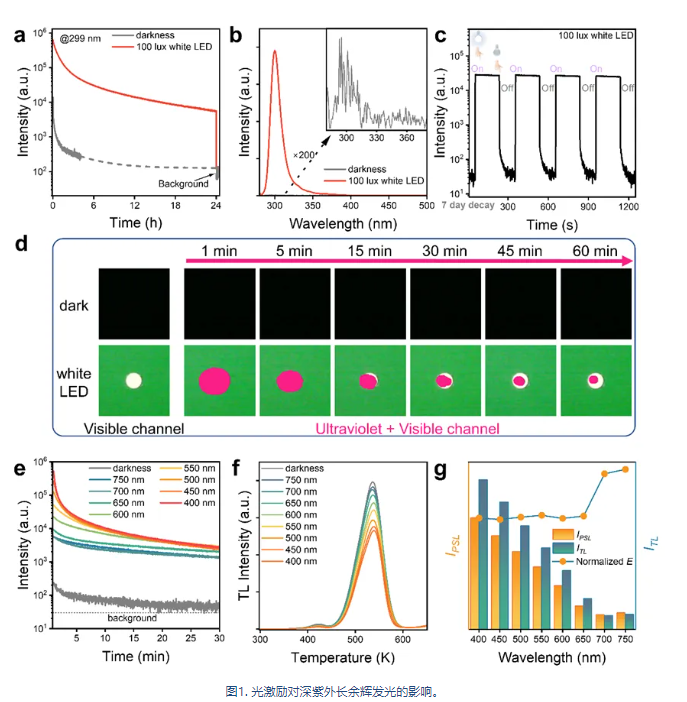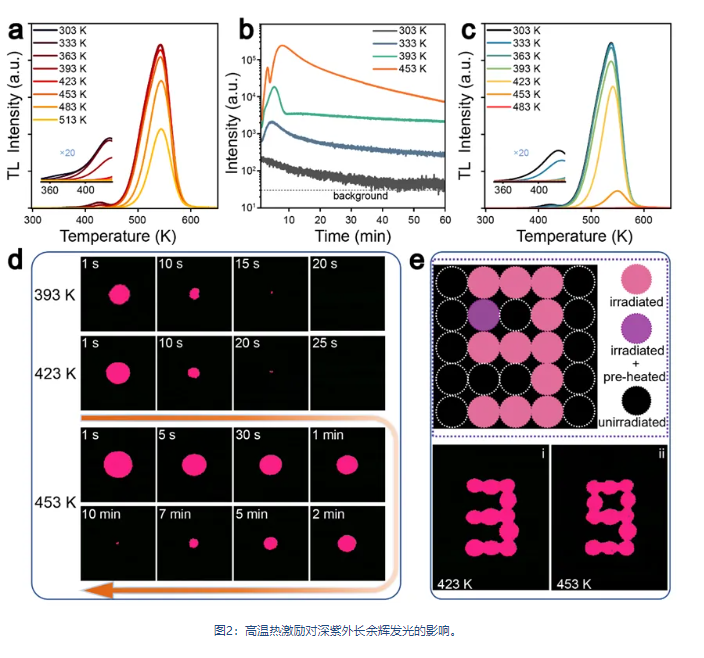20
2024
-
12
Deep trap ultraviolet long afterglow luminescent materials for optical information storage in bright field environments.
Author:
Long afterglow luminescent materials are a special type of photoluminescent materials that can continue to emit light even after external excitation (such as ultraviolet rays, high-energy X-rays, sunlight, etc.) stops. The duration of the luminescence can range from a few seconds to several weeks. Due to their unique delayed luminescence characteristics, these materials are widely used in fields such as low-light illumination, optical anti-counterfeiting, information storage and display, and biomedicine. However, the emission wavelengths of developed long afterglow luminescent materials mainly focus on the visible and near-infrared light bands, and research on long afterglow luminescence has primarily concentrated on characterization and applications in dark environments, such as night vision tracking, photoluminescent anti-counterfeiting marks, and biological imaging probes. Because of this, people often consider long afterglow luminescence to be spontaneous light emission in dark environments and tend to regard dark conditions as a necessary condition for the study and application of long afterglow luminescent materials while neglecting the role of external light excitation (outdoor sunlight or indoor lighting). This traditional thinking based on room temperature thermal excitation limits the application and development of long afterglow materials in bright environments.
From the perspective of the energy storage and release physical mechanism of long afterglow materials, long afterglow emission should not only occur in dark environments. As long as there is no spectral overlap between the material's light emission and the surrounding ambient light (such as indoor lighting or surface sunlight), long afterglow luminescent materials can be applied in bright environments. This special form of luminescence can be seen as a combination of long afterglow luminescence in dark environments with light-excited luminescence in bright environments; that is, joint excitation by environmental heat and environmental light. To achieve detectable long afterglow emission in bright environments, it is necessary to avoid spectral overlap between the long afterglow emission spectrum and ambient light spectrum; this requires that the residual glow emission wavelength be less than 300 nm for deep ultraviolet light. Additionally, the material itself needs to have a relatively deep trap depth (generally greater than 1.0 eV) and a high trap density to reduce thermal escape of captured carriers under room temperature thermal excitation while effectively releasing stored energy under ambient light excitation. Therefore, deep trap long afterglow materials with deep ultraviolet emission characteristics provide new options for achieving detectable long afterglow emissions in bright environments.
To address these issues, the research team reported a deep trap ultraviolet long afterglow luminescent material—ScBO—with an emission peak at 299 nm and a thermoluminescence main peak >500 K.3:Bi3+. Strong and persistent deep ultraviolet emissions were achieved through indoor lighting excitation or high-temperature thermal excitation. The effects of ambient light intensity, excitation wavelength, and environmental temperature on deep ultraviolet long afterglow performance were studied alongside first-principles calculations exploring the nature of traps. This research has significant implications for new functional applications of deep trap ultraviolet long afterglow materials in optical positioning and tracking unaffected by surrounding ambient light interference as well as optical information storage.
The effect of optical excitation on deep ultraviolet long afterglow luminescence
ScBO3:Bi3+After X-ray excitation, only weak residual glow was produced under room temperature dark conditions; however, under continuous indoor lighting stimulation, its deep ultraviolet long afterglow was significantly enhanced due to efficient release of stored energy from deep traps under indoor lighting stimulation (Figure 1a,b). The energy stored in deep traps naturally decayed over seven days but still maintained over 70% of its initial value in a room temperature dark environment; moreover, residual glow signals could be effectively enhanced by indoor lighting by more than 1000 times (Figure 1c). Figure 1d shows photos taken with an ultraviolet camera capturing ScBO samples' deep ultraviolet long afterglows under dark conditions versus indoor lighting conditions (with pink areas representing deep ultraviolet residual glow). Considering the broad spectral composition of indoor lighting, this study also explored how monochromatic lights at different wavelengths affect energy release from storage and enhancement of deep ultraviolet residual glow while introducing an effective factor (E=I)3:Bi3+PSL TL) to describe how much energy released during monochromatic continuous stimulation converts into effective deep ultraviolet long-after-glow emissions (Figure 1e-g).PSL/ITL)来描述单色光持续激励过程中所释放的能量转化为深紫外长余辉发光的有效性(图1e-g)。

高温热激励对深紫外长余辉发光的影响
除了光激励之外,高温热激励也是加速深陷阱中能量释放进而实现余辉发光增强的有效手段。对于ScBO3:Bi3+,当环境温度低于423 K时,由于陷阱深度较深,此时的热激励不足以使深陷阱中能量有效释放;只有当环境温度高于423 K时,深陷阱中的能量才能被有效释放出来,产生明显的增强深紫外长余辉发光信号,且增强的余辉发光在较高的环境温度下仍能持续数个小时(图2a-c)。高温热激励发光也可以通过紫外相机拍摄直观地表现出来。由于相机灵敏度的限制,在393 K和423 K时,余辉发光仅能被拍摄到20秒左右;而当温度升高到453 K时,可以拍摄到10分钟以上深紫外长余辉发光(图2d)。图2e中上半部分为所设计的信息存储应用展示,其中粉色区域代表激发之后的样品(有效信息);紫色区域代表激发之后并在423 K预加热30秒的样品(有效信息)。当在不同温度读出信息时,只有当温度达到453K,正确的数字信息才可以被有效读出。

本文报道了ScBO3:碧3+, through environmental light stimulation or high-temperature thermal stimulation achieved strong persistent deep ultraviolet emissions while thoroughly investigating how ambient light intensity, excitation wavelength along with environmental temperature affect these emissions.Combining first-principles calculations exploring internal trap nature revealed that Sc interstitials Scand oxygen vacancies VOare primary reasons for forming internal deep trap levels within the material. Finally presenting an application scheme for optical information reading via either optical or thermal stimulation. This research will provide new ideas for designing developing applications for deep trap UV-long-after-glowing materials.
LATEST NEWS
2025-01-09
Design and Development of Full-Spectrum Photodetectors
In recent years, the booming optoelectronic industry has changed the world and extended into many aspects of life. Among them, photodetectors (PDs) with a wide response bandwidth from deep ultraviolet to visible to near-infrared serve as important optoelectronic components and play a key role in daily life.
2025-01-08
Black arsenene multi-spectral integrated field-effect transistors, aiding high-resolution imaging and enhanced secure communication.
With the development of modern communication technology, the demand for broadband, room-temperature infrared, and terahertz (THz) detectors has rapidly increased. These detectors play a crucial role in fields such as telecommunications, security inspection, non-destructive testing, and medical diagnostics. However, existing optical detectors face challenges such as high intrinsic dark current and the need for low-temperature cooling, which limit their efficiency in detecting low-energy photons. Particularly in the terahertz band, the photon energy is insufficient to excite electron transitions from the valence band maximum (VBM) to the conduction band minimum (CBM), making effective optoelectronic conversion difficult. Therefore, researchers have been seeking ultra-broadband detectors that can operate at room temperature and respond to wavelengths ranging from visible light to the terahertz band.
2024-12-30
Laser-based tiered neurons achieve high-speed reservoir computing.
Neuromorphic computing is a computational paradigm that simulates the functions and architecture of biological neurons. A single biological neuron is a powerful computational unit with information processing capabilities, information transmission abilities, and memory functions. Therefore, it is crucial to design a photonic neuromorphic processor that can truly emulate the powerful computational functions of biological neurons.
2025-01-01
Design and Development of Full-Spectrum Photodetectors
In recent years, the rapidly growing optoelectronic industry has changed the world and extended into many aspects of life. Among them, photodetectors (PDs) with a wide spectral response from deep ultraviolet to visible to near-infrared serve as important optoelectronic components and play a key role in daily life.
2024-12-31
High-sensitivity quantum dot photodetectors from deep ultraviolet to near-infrared
In recent years, the rapidly growing optoelectronic industry has changed the world and extended into many aspects of life. Among them, photodetectors (PD) with deep ultraviolet-visible-near infrared full spectrum detection response serve as important optoelectronic components, playing a key role in daily life.

